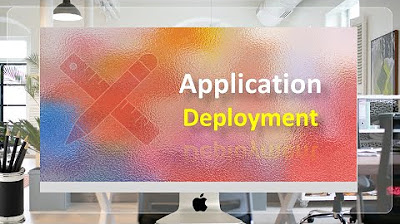Laravel deployment with GitHub Actions
Summary
TLDRIn this debut YouTube video, Filo, a self-taught developer with 20 years of experience, guides viewers through deploying an application to multiple servers without downtime using GitHub Actions. He begins by creating a new GitHub repository and using Laravel for demonstration, though the method is adaptable to other frameworks. The video covers the steps of setting up GitHub workflows, configuring YAML files, and preparing the application for production. Filo demonstrates creating deployment artifacts, configuring PHP, and managing npm and composer dependencies. The video includes tips on creating a server list JSON file, handling artifacts, and ensuring a seamless deployment across multiple servers. Filo troubleshoots common issues, emphasizing best practices in deployment and server management.
Takeaways
- 😄 Filo, a self-taught developer, shares his journey and expertise through his first YouTube video, focusing on deploying applications without downtime using GitHub Actions.
- 💻 GitHub Actions is introduced as a powerful tool to automate workflows, allowing deployment to multiple servers upon a commit to the master branch.
- 📲 Filo uses a Laravel application for demonstration but emphasizes that the process can be applied to any project, highlighting the versatility of GitHub Actions.
- 🔧 The video tutorial covers the creation of a GitHub repository, setting up a workflow with YAML syntax, and preparing the application for the production environment.
- 🛠 Key steps in the workflow include checking out the code, compiling assets with NPM, configuring PHP, installing Composer dependencies, and creating a deployable artifact.
- 🔍 Filo demonstrates how to dynamically name the deployment artifact using the commit hash for easier identification and manageability of releases.
- 🔒 The process includes securely configuring server information within a JSON file, showcasing how to handle multiple deployment targets within GitHub Actions.
- 🚨 Challenges like password requirements and environment variable configurations are addressed, showing how to troubleshoot and adjust workflows.
- 🔨 Filo navigates through server setup on DigitalOcean, including SSH access and configuring Nginx to point to the correct directory for the deployed application.
- 💡 The script concludes by detailing cleanup processes to maintain server health and demonstrating the deployment across multiple servers, showcasing scalability.
Q & A
What is the purpose of this video?
-The purpose of this video is to demonstrate how to deploy a Laravel application to multiple servers without any downtime using GitHub Actions.
What is GitHub Actions, and how does it work in this context?
-GitHub Actions is a feature that allows you to trigger workflows when specific GitHub events occur, such as pushing commits to a branch. In this video, it is used to automate the deployment process of a Laravel application to multiple servers.
What are the main steps involved in the deployment process demonstrated in the video?
-The main steps include setting up the workflow, creating deployment artifacts, uploading artifacts to servers, extracting archives, running before and after hooks, activating the release by symlink swapping, and cleaning up old releases and artifacts.
How does the video handle the Laravel environment configuration during deployment?
-The video creates an environment variable containing the Laravel environment configuration (including database settings, app name, etc.) as a GitHub secret. During deployment, it generates an .env file in the release directory by printing the contents of this secret.
What is the purpose of the 'before' and 'after' hooks in the deployment process?
-The 'before' hook allows running commands before the release is activated, such as running database migrations or backups. The 'after' hook allows running commands after the release is activated, such as sending notifications.
How does the video handle shared storage between different releases?
-The video creates a shared 'storage' directory outside of the release directories. During deployment, it removes the 'storage' directory from the release and symlinks it to the shared storage directory.
What is the purpose of the 'cleanup' step in the deployment process?
-The 'cleanup' step removes old release directories and artifacts directories from the servers, keeping only a limited number of recent releases to conserve disk space.
How does the video handle deploying to multiple servers?
-The video uses a deployment matrix configuration, which allows the deployment steps to be executed in parallel on multiple servers defined in a JSON configuration file.
What is the role of the 'symlink swap' technique used in the video?
-The 'symlink swap' technique involves creating a symbolic link called 'current' that points to the new release directory. This allows switching to the new release without any downtime by simply updating the symlink.
What additional considerations should be taken into account when deploying to production servers?
-The video mentions using repository secrets and SSH keys instead of hardcoding credentials in the configuration file. Additionally, it's recommended to follow best practices for security, monitoring, and error handling in a production environment.
Outlines

This section is available to paid users only. Please upgrade to access this part.
Upgrade NowMindmap

This section is available to paid users only. Please upgrade to access this part.
Upgrade NowKeywords

This section is available to paid users only. Please upgrade to access this part.
Upgrade NowHighlights

This section is available to paid users only. Please upgrade to access this part.
Upgrade NowTranscripts

This section is available to paid users only. Please upgrade to access this part.
Upgrade NowBrowse More Related Video

How to Build Loop With a Web Browser

Deploying Application in Oracle APEX - Part 39

Purchasing a Domain + Hosting TextUtils on a VPS | Complete React Course in Hindi #18

How To Deploy Serverless SAM Using Code Pipeline (5 Min) | Using AWS Code Build & Code Commit

DP-203: 01 - Introduction

3. Prerequisites to setup F5 lab || How to install Webserver on windows 10 machine || F5 Big-IP LTM
5.0 / 5 (0 votes)